This essay was originally published in The Public Domain Review under a Creative Commons License. Please see their rules for reuse.
In contrast to today’s rather mundane spawn of coffeehouse chains, the London of the 17th and 18th century was home to an eclectic and thriving coffee drinking scene. Dr Matthew Green explores the halcyon days of the London coffeehouse, a haven for caffeine-fueled debate and innovation which helped to shape the modern world.
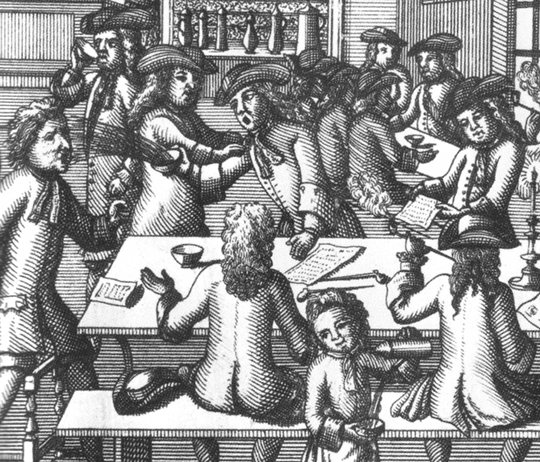
From the tar-caked wharves of Wapping to the gorgeous lamp-lit squares of St James’s and Mayfair, visitors to eighteenth-century London were amazed by an efflorescence of coffeehouses. “In London, there are a great number of coffeehouses”, wrote the Swiss noble César de Saussure in 1726, “…workmen habitually begin the day by going to coffee-rooms to read the latest news.” Nothing was funnier, he smirked, than seeing shoeblacks and other riffraff poring over papers and discussing the latest political affairs. Scottish spy turned travel writer John Macky was similarly captivated in 1714. Sauntering into some of London’s most prestigious establishments in St James’s, Covent Garden and Cornhill, he marvelled at how strangers, whatever their social background or political allegiances, were always welcomed into lively convivial company. They were right to be amazed: early eighteenth-century London boasted more coffeehouses than any other city in the western world, save Constantinople.
London’s coffee craze began in 1652 when Pasqua Rosée, the Greek servant of a coffee-loving British Levant merchant, opened London’s first coffeehouse (or rather, coffee shack) against the stone wall of St Michael’s churchyard in a labyrinth of alleys off Cornhill. Coffee was a smash hit; within a couple of years, Pasqua was selling over 600 dishes of coffee a day to the horror of the local tavern keepers. For anyone who’s ever tried seventeenth-century style coffee, this can come as something of a shock — unless, that is, you like your brew “black as hell, strong as death, sweet as love”, as an old Turkish proverb recommends, and shot through with grit.
It’s not just that our tastebuds have grown more discerning accustomed as we are to silky-smooth Flat Whites; contemporaries found it disgusting too. One early sampler likened it to a “syrup of soot and the essence of old shoes” while others were reminded of oil, ink, soot, mud, damp and shit. Nonetheless, people loved how the “bitter Mohammedan gruel”, as The London Spy described it in 1701, kindled conversations, fired debates, sparked ideas and, as Pasqua himself pointed out in his handbill The Virtue of the Coffee Drink (1652), made one “fit for business” — his stall was a stone’s throw from that great entrepôt of international commerce, the Royal Exchange.
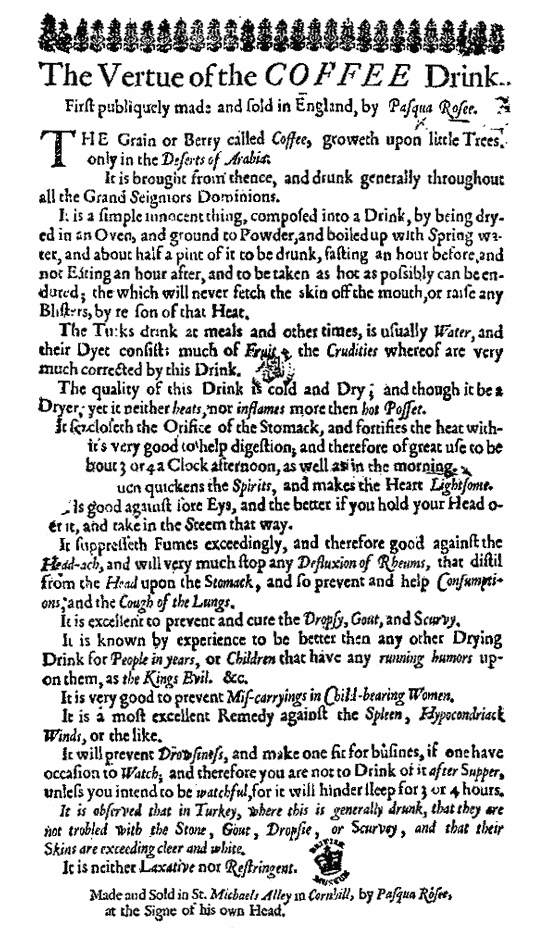
Remember — until the mid-seventeenth century, most people in England were either slightly — or very — drunk all of the time. Drink London’s fetid river water at your own peril; most people wisely favoured watered-down ale or beer (“small beer”). The arrival of coffee, then, triggered a dawn of sobriety that laid the foundations for truly spectacular economic growth in the decades that followed as people thought clearly for the first time. The stock exchange, insurance industry, and auctioneering: all burst into life in 17th-century coffeehouses — in Jonathan’s, Lloyd’s, and Garraway’s — spawning the credit, security, and markets that facilitated the dramatic expansion of Britain’s network of global trade in Asia, Africa and America.
The meteoric success of Pasqua’s shack triggered a coffeehouse boom. By 1656, there was a second coffeehouse at the sign of the rainbow on Fleet Street; by 1663, 82 had sprung up within the crumbling Roman walls, and a cluster further west like Will’s in Covent Garden, a fashionable literary resort where Samuel Pepys found his old college chum John Dryden presiding over “very pleasant and witty discourse” in 1664 and wished he could stay longer — but he had to pick up his wife, who most certainly would not have been welcome.
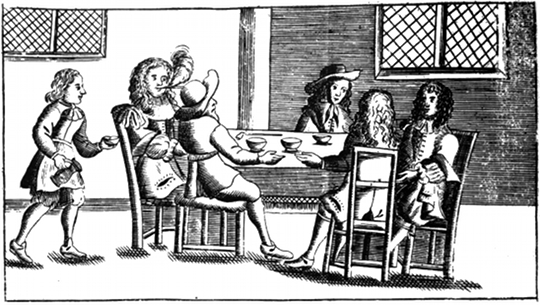
No respectable women would have been seen dead in a coffeehouse. It wasn’t long before wives became frustrated at the amount of time their husbands were idling away “deposing princes, settling the bounds of kingdoms, and balancing the power of Europe with great justice and impartiality”, as Richard Steele put it in the Tatler, all from the comfort of a fireside bench. In 1674, years of simmering resentment erupted into the volcano of fury that was the Women’s Petition Against Coffee. The fair sex lambasted the “Excessive use of that Newfangled, Abominable, Heathenish Liquor called COFFEE” which, as they saw it, had reduced their virile industrious men into effeminate, babbling, French layabouts. Retaliation was swift and acerbic in the form of the vulgar Men’s Answer to the Women’s Petition Against Coffee, which claimed it was “base adulterate wine” and “muddy ale” that made men impotent. Coffee, in fact, was the Viagra of the day, making “the erection more vigorous, the ejaculation more full, add[ing] a spiritual ascendency to the sperm”.
There were no more Women’s Petitions after that but the coffeehouses found themselves in more dangerous waters when Charles II, a longtime critic, tried to torpedo them by royal proclamation in 1675. Traditionally, informed political debate had been the preserve of the social elite. But in the coffeehouse it was anyone’s business — that is, anyone who could afford the measly one-penny entrance fee. For the poor and those living on subsistence wages, they were out of reach. But they were affordable for anyone with surplus wealth — the 35 to 40 per cent of London’s 287,500-strong male population who qualified as ‘middle class’ in 1700 — and sometimes reckless or extravagant spenders further down the social pyramid. Charles suspected the coffeehouses were hotbeds of sedition and scandal but in the face of widespread opposition — articulated most forcefully in the coffeehouses themselves — the King was forced to cave in and recognise that as much as he disliked them, coffeehouses were now an intrinsic feature of urban life.
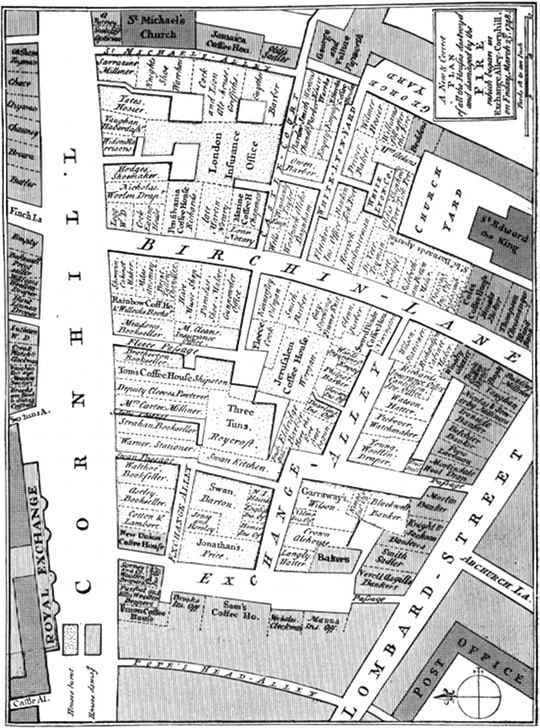
By the dawn of the eighteenth century, contemporaries were counting between 1,000 and 8,000 coffeehouses in the capital even if a street survey conducted in 1734 (which excluded unlicensed premises) counted only 551. Even so, Europe had never seen anything like it. Protestant Amsterdam, a rival hub of international trade, could only muster 32 coffeehouses by 1700 and the cluster of coffeehouses in St Mark’s Square in Venice were forbidden from seating more than five customers (presumably to stifle the coalescence of public opinion) whereas North’s, in Cheapside, could happily seat 90 people.
The character of a coffeehouse was influenced by its location within the hotchpotch of villages, cities, squares, and suburbs that comprised eighteenth-century London, which in turn determined the type of person you’d meet inside. “Some coffee-houses are a resort for learned scholars and for wits,” wrote César de Saussure, “others are the resort of dandies or of politicians, or again of professional newsmongers; and many others are temples of Venus.” Flick through any of the old coffeehouse histories in the public domain and you’ll soon get a flavour of the kaleidoscopic diversity of London’s early coffeehouses.
The walls of Don Saltero’s Chelsea coffeehouse were festooned with taxidermy monsters including crocodiles, turtles and rattlesnakes, which local gentlemen scientists like Sir Isaac Newton and Sir Hans Sloane liked to discuss over coffee; at White’s on St James’s Street, famously depicted by Hogarth, rakes would gamble away entire estates and place bets on how long customers had to live, a practice that would eventually grow into the life insurance industry; at Lunt’s in Clerkenwell Green, patrons could sip coffee, have a haircut and enjoy a fiery lecture on the abolition of slavery given by its barber-proprietor John Gale Jones; at John Hogarth’s Latin Coffeehouse, also in Clerkenwell, patrons were encouraged to converse in the Latin tongue at all times (it didn’t last long); at Moll King’s brothel-coffeehouse, depicted by Hogarth, libertines could sober up and peruse a directory of harlots, before being led to the requisite brothel nearby. There was even a floating coffeehouse, the Folly of the Thames, moored outside Somerset House where fops and rakes danced the night away on her rain-spattered deck.
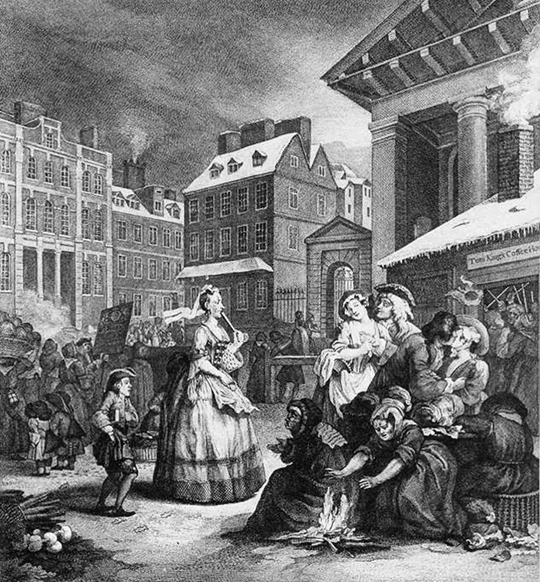
Despite this colourful diversity, early coffeehouses all followed the same blueprint, maximising the interaction between customers and forging a creative, convivial environment. They emerged as smoky candlelit forums for commercial transactions, spirited debate, and the exchange of information, ideas, and lies. This small body-colour drawing shows an anonymous (and so, it’s safe to assume, fairly typical) coffeehouse from around 1700.
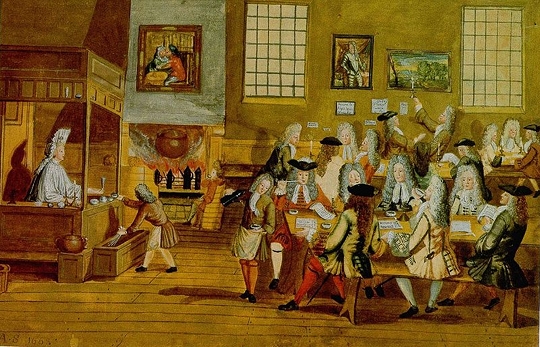
Looking at the cartoonish image, decorated in the same innocent style as contemporary decorated fans, it’s hard to reconcile it with Voltaire’s rebuke of a City coffeehouse in the 1720s as “dirty, ill-furnished, ill-served, and ill-lighted” nor particularly London Spy author Ned Ward’s (admittedly scurrilous) evocation of a soot-coated den of iniquity with jagged floorboards and papered-over windows populated by “a parcel of muddling muck-worms…some going, some coming, some scribbling, some talking, some drinking, others jangling, and the whole room stinking of tobacco.” But, the establishments in the West End and Exchange Alley excepted, coffeehouses were generally spartan, wooden and no-nonsense.
As the image shows, customers sat around long communal tables strewn with every type of media imaginable listening in to each other’s conversations, interjecting whenever they pleased, and reflecting upon the newspapers. Talking to strangers, an alien concept in most coffee shops today, was actively encouraged. Dudley Ryder, a young law student from Hackney and shameless social climber, kept a diary in 1715-16, in which he routinely recalled marching into a coffeehouse, sitting down next to a stranger, and discussing the latest news. Private boxes and booths did begin to appear from the late 1740s but before that it was nigh-on impossible to hold a genuinely private conversation in a coffeehouse (and still pretty tricky afterwards, as attested to by the later coffeehouse print below). To the left, we see a little Cupid-like boy in a flowing periwig pouring a dish of coffee à la mode — that is, from a great height — which would fuel some coffeehouse discussion or other.
Much of the conversation centred upon news:
There’s nothing done in all the world
From Monarch to the Mouse,
But every day or night ’tis hurled
Into the Coffee-House
chirped a pamphlet from 1672. As each new customer went in, they’d be assailed by cries of “What news have you?” or more formally, “Your servant, sir, what news from Tripoli?” or, if you were in the Latin Coffeehouse, “Quid Novi!” That coffeehouses functioned as post-boxes for many customers reinforced this news-gathering function. Unexpectedly wide-ranging discussions could be twined from a single conversational thread as when, at John’s coffeehouse in 1715, news about the execution of a rebel Jacobite Lord (as recorded by Dudley Ryder) transmogrified into a discourse on “the ease of death by beheading” with one participant telling of an experiment he’d conducted slicing a viper in two and watching in amazement as both ends slithered off in different directions. Was this, as some of the company conjectured, proof of the existence of two consciousnesses?
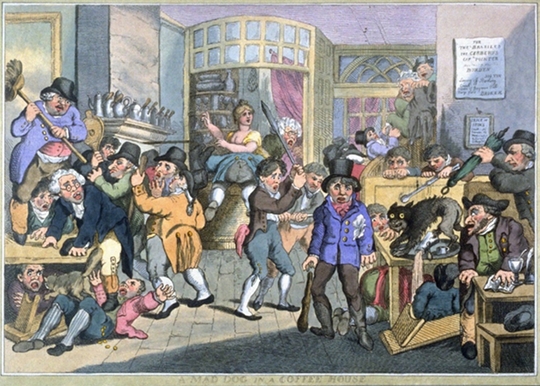
If the vast corpus of 17th-century pamphlet literature is anything to go by then early coffeehouses were socially inclusive spaces where lords sat cheek-by-jowl with fishmongers and where butchers trumped baronets in philosophical debates. “Pre-eminence of place none here should mind,” proclaimed the Rules and Orders of the Coffee-House (1674), “but take the next fit seat he can find” — which would seem to chime with John Macky’s description of noblemen and “private gentlemen” mingling together in the Covent Garden coffeehouses “and talking with the same Freedom, as if they had left their Quality and Degrees of Distance at Home.”
Perhaps. But propagandist apologias and wondrous claims of travel-writers aside, more compelling evidence suggests that far from co-existing in perfect harmony on the fireside bench, people in coffeehouses sat in relentless judgement of one another. At the Bedford Coffeehouse in Covent Garden hung a “theatrical thermometer” with temperatures ranging from “excellent” to “execrable”, registering the company’s verdicts on the latest plays and performances, tormenting playwrights and actors on a weekly basis; at Waghorn’s and the Parliament Coffee House in Westminster, politicians were shamed for making tedious or ineffectual speeches and at the Grecian, scientists were judged for the experiments they performed (including, on one occasion, dissecting a dolphin). If some of these verdicts were grounded in rational judgement, others were forged in naked class prejudice. Visiting Young Slaughter’s coffeehouse in 1767, rake William Hickey was horrified by the presence of “half a dozen respectable old men”, pronouncing them “a set of stupid, formal, ancient prigs, horrid periwig bores, every way unfit to herd with such bloods as us”.
But the coffeehouse’s formula of maximised sociability, critical judgement, and relative sobriety proved a catalyst for creativity and innovation. Coffeehouses encouraged political debate, which paved the way for the expansion of the electorate in the 19th century. The City coffeehouses spawned capitalist innovations that shaped the modern world. Other coffeehouses sparked journalistic innovation. Nowhere was this more apparent than at Button’s coffeehouse, a stone’s throw from Covent Garden piazza on Russell Street.
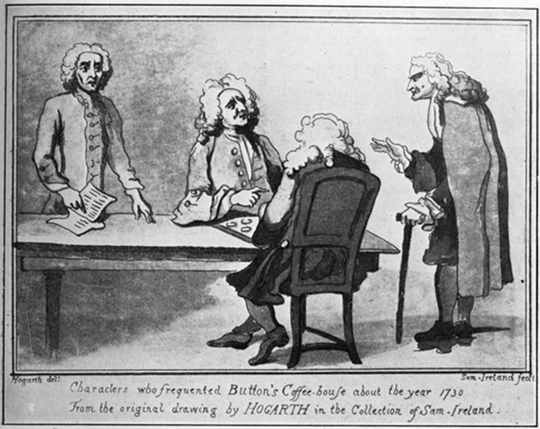
It was opened in 1712 by the essayist and playwright Joseph Addison, partly as a refuge from his quarrelsome marriage, but it soon grew into a forum for literary debate where the stars of literary London — Addison, Steele, Pope, Swift, Arbuthnot and others — would assemble each evening, casting their superb literary judgements on new plays, poems, novels, and manuscripts, making and breaking literary reputations in the process. Planted on the western side of the coffeehouse was a marble lion’s head with a gaping mouth, razor-sharp jaws, and “whiskers admired by all that see them”. Probably the world’s most surreal medium of literary communication, he was a playful British slant on a chilling Venetian tradition.
As Addison explained in the Guardian, several marble lions “with mouths gaping in a most enormous manner” defended the doge’s palace in Venice. But whereas those lions swallowed accusations of treason that “cut off heads, hang, draw, and quarter, or end in the ruin of the person who becomes his prey”, Mr Addison’s was as harmless as a pussycat and a servant of the public. The public was invited to feed him with letters, limericks, and stories. The very best of the lion’s digest was published in a special weekly edition of the original Guardian, then a single-sheet journal costing one-and-a-half pence, edited inside the coffeehouse by Addison. When the lion “roared so loud as to be heard all over the British nation” via the Guardian, writing by unknown authors was beamed far beyond the confines of Button’s making the public — rather than a narrow clique of wits — the ultimate arbiters of literary merit. Public responses were sometimes posted back to the lion in a loop of feedback and amplification, mimicking the function of blogs and newspaper websites today (but much more civil).
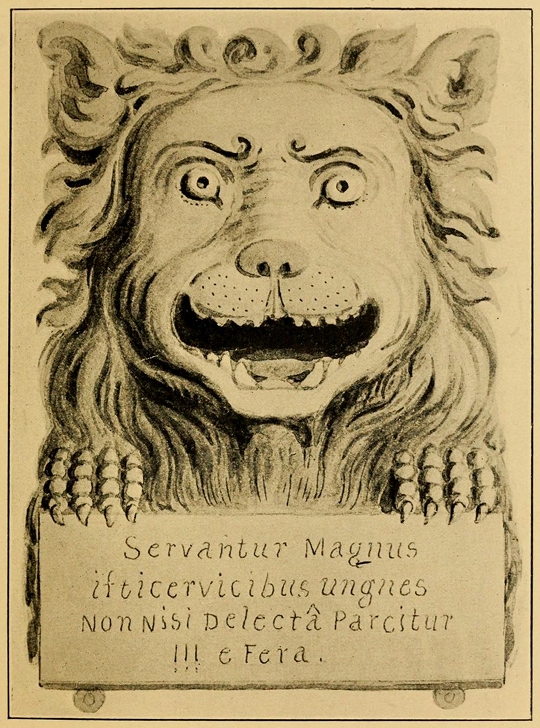
If you’re thinking of visiting Button’s today, brace yourself: it’s a Starbucks, one of over 300 clones across the city. The lion has been replaced by the “Starbucks community notice board” and there is no trace of the literary, convivial atmosphere of Button’s. Addison would be appalled.
Dr Matthew Green graduated from Oxford University in 2011 with a PhD in the impact of the mass media in 18th-century London. He works as a writer, broadcaster, freelance journalist, and lecturer. He is the co-founder of Unreal City Audio, which produces immersive, critically-acclaimed tours of London as live events and audio downloads. His limited edition hand-sewn pamphlet, The Lost World of the London Coffeehouse, published by Idler Books, is on sale now:
http://unrealcityaudio.co.uk/shop/
Unreal City Audio Tours — Join actors, musicians, and Dr Matthew Green for an immersive whirlwind tour of London’s original coffeehouses every month. Featuring free shots of 17th-century style coffee! See website for details. Or download an epic two-hour coffeehouse audio tour, vividly reconstructing the lost acoustic world of 17th and 18th-century London and featuring performances by 13 actors, Dr Matthew Green’s narration, and broadside ballads all woven into a cinematic soundscape –
http://unrealcityaudio.co.uk/